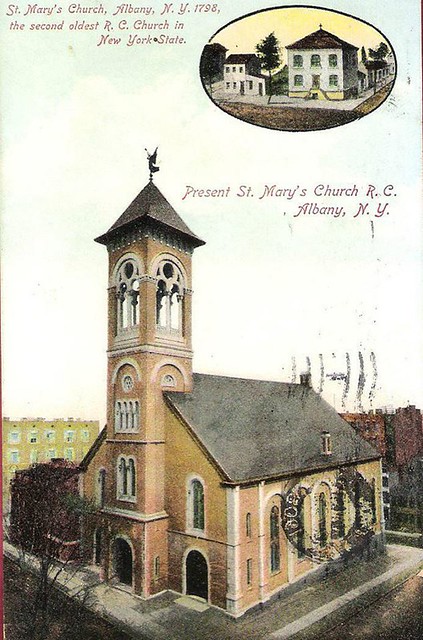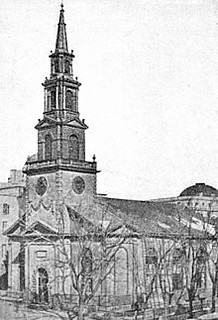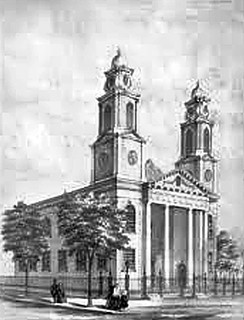During the 19th century, many changes occurred in the United States. The Union was nearly torn apart when the South seceded and the Civil War was being fought. There was also a change in culture and industry. The United States began to transition from a WASP-y agrarian culture to one that was more industrial and less anglo-saxon, although this would be confined to much of the late 19th century. Christianity also began to change during this time too. As immigrants from Europe began to settle in the country, they brought different forms of Christianity. Irish Catholics in particular, would come to dominate Catholicism by the end of the 19th century, and the beginning of the early 20th century, especially in the Northeastern United States. However, there were some issues regarding the increasing number of Catholics in the United States, and anti-Catholic/nativist movements became increasingly prominent. It was during this time that evangelical protestantism began to appear in the country. Movements stemming from the Great Awakenings that occurred in waves during the 18th and 19th centuries were beginning to have larger affects on mainline protestantism. In this selection of scholarly works, these movements and demographic changes will be examined on a national, regional, and statewide scale.
In order to understand Christianity in the United States, it is necessary to discuss the religion of the colonies, and how religious diversification began to happen in the 19th century. In David, Wills’s Christianity in the United States, (specifically the chapter, “Colonies in the Atlantic World”) he lays a groundwork for the reader to understand the various sects of the religion as they have come to exist in the United States. Wills makes the case that in order to understand Christianity in the United States, it is important to know that it is rooted in the history of the Atlantic States (Wills, 5). This would make sense, as most of the voyages of exploration that occurred from the 15th century onward ended in the Americas, and thus would be the basis for the countries that would form out of this discovery. Wills makes the point that Protestants weren’t always the dominant group in North America, as many Catholics from Spain, Portugal, and France had already settled in parts of the continent by the early 17th century (Wills, 7). It wasn’t until the Dutch and the English began claiming territory that demographics began to change. When permanent settlements were established (Jamestown, Providence, the Massachusetts Bay Colony), British Christianity in particular began to grow (Wills, 7-9). Wills goes on to say that the three regions of the colonies (New England, Middle, and Southern) all had different defining characteristics. New England’s religious groups tended to support morality and social justice, while the Middle Colonies, which were more ethnically diverse focused on toleration and religious liberty(a by product of Quaker settlement, apparently) (Wills, 11-13). The South, in contrast with the other two, would resemble the colonies in New England, if not for the separation of religious groups based on race, and the fact that different religious traditions (Islam and traditional forms of African religion) were brought into the country by enslaved Africans (Wills, 13-14). As Wills continues, he writes about how there are disputes as to whether the United States was formed under the auspices of European Enlightenment ideals, or Great Awakening theology. While he doesn’t give a conclusive answer, he does provide evidence that the First Great Awakening was made more important retrospectively, than it actually was in the 19th century (Wills, 15). He also states that, under the leadership of Thomas Jefferson and James Madison, who were both deistically inclined, instituted religious freedom into the Constitution through the ratification of the First Amendment (Wills, 15). The actions here would have repercussions in the next century, as not everyone was overjoyed with this foundational principle. While Wills’s book is a great introduction, its brevity causes some issues, as he doesn’t go as in depth as other authors do.
The next book, Religion in America, by Denis Lacorne, deals with similar issues as Wills, but with greater depth (see above criticism). Concentrating on the chapter, “Evangelical Awakenings” and “Bible Wars”, Lacorne picks up where Wills ended, and deals with the religious revivals that occurred in the United States during the 18th and 19th centuries. Lacorne describes how the democratization of religion challenged Puritanical religious thought in the 19th century, and would affect relations between religion and politics for decades to come, and would play a role in causing revivals (Lacorne, 44). These Awakenings also disproportionately affected Protestant sects, with Baptists and Methodists enjoying greater growth than older sects (Presbyterian and Episcopalian, Lacorne, 44-45). When the Great Awakenings began, philosophers and writers, for example Alexis de Tocqueville, saw the rise of evangelical Protestantism as a passing phenomenon that would not affect many people, which would be incorrect, as Lacorne writes that Tocqueville underestimated the power of these new sects (Lacorne, 55).
In the following chapter, “Bible Wars”, Lacorne shifts from just the Great Awakenings and rise of evangelical Christianity to the conflicts that arose between Catholics and evangelicals during the 19th century. While Catholics in the colonies were in the minority of Christian denominations in the late 18th century, there was an explosive amount of growth during the 19th century as Irish, Italian, and German Catholics immigrated to the United States. By the 1850s, there were over a million Catholics in the country, up from about 35,000 just sixty years prior (Lacorne, 64). Anti-Catholic sentiment already existed due to English propaganda, which regarded the largely Irish immigrants as papists who threatened American democracy (Lacorne, 65). Combined with bad press and evangelical Protestantism, anti-Catholic riots began to occur throughout the 1830s, with Irish neighborhoods in Boston being looted, while a convent in Charleston was set ablaze by rioters (Lacorne, 65-66). Riots would continue into the next decade, culminating in a period of a few months in Philadelphia (Kensington to be exact), where Irish neighborhoods were, again, attacked and looted (Lacorne,77). A source of the issues between Protestants and Catholics in the United States was over which translation was used. According to Lacorne, Irish Catholics in particular favored the Douai Bible, while Protestants used the King James Version (apparently there are major differences, hell if I know though, they all sound the same to me, Lacorne, 69). One of the key events in the dispute over Bibles occurred in 1859, when an Irish student at a public school refused to recite the King James version of the Ten Commandments. As a result, his knuckles were whipped until they bled, and when other Irish students stood in solidarity, they were expelled (Lacorne, 72-73). This led to legal battle over whether or not the student should have been punished so severely, but it was eventually decided that refusing to recite the King James commandments was a violation of student obligations in Boston public schools (Lacorne, 73). While the court case was a failure, the student became a martyr in the eyes of Catholics around the country, and would be used as a symbol against anti-Catholicism (Lacorne, 77). While Lacorne makes the case that anti-Catholicism was part of the reason for violence on the part of Protestants, he also adds that there were other reasons for this occurring. The Irish, during the mid-19th century, were seen as low wage workers who were stealing jobs from hardworking Americans (that sounds familiar), not only threatening the political and social stability of the United States, but also the economic livelihood of “native-born” citizens (Lacorne, 78). Compared to Wills’s book, Lacorne’s is much more in depth, as stated earlier, but there are some issues, one of which was the fact that he goes out of order, listing the events of the “Bible War” before the Kensington riots, even though the it happened in 1859, while the riots occurred in 1844. There is also a problem with the fact that when he describes the criticisms of the Great Awakenings, he uses only four sources, Tocqueville, Fanny Trollope, Michel Chevalier, and Gustave Beaumont, leading to a skewed perspective as to what philosophers and foreign visitors thought of the revivals of the 19th century.
Coinciding with the rise of Protestant Evangelicalism was an increase in anti-Catholicism. While the Great Awakenings and nativist thought may not have been mutually exclusive, Charles Hambrick-Stowe makes the case for there being a direct connection between the two. According to Hambrick-Stowe in his article, “Charles G. Finney and Evangelical Anti-Catholicism”, this movement was rooted in animosity towards the “official disestablishment of churches and rising religious diversity” (Hambrick-Stowe, 39). This would make sense, as during the 18th century, the rise of Enlightenment Era thought in the United States, coupled with the immigration that occurred in the 19th century, may have been disconcerting to Protestants who felt that their status as majority was in danger of being threatened.
The man at the center of this article, Charles G. Finney, was a minister from the Burned-Over-District of Western New York (a phrase that he coined, coincidentally). The Burned-Over-District, which encapsulated at least a dozen or so counties in New York, was a hotbed for religious revivals in the 19th century (including the establishment of Mormonism), one of which involved Finney. The preacher felt, with regards to Catholics, that they were bound by outdated tradition that prevented the dissemination of the Gospel in America (Hambrick-Stowe, 43). While Finney never explicitly attacked Catholicism (concentrating more on converting and “saving” them from sin, Hambrick-Stowe, 44), his rhetoric was important in fostering the development of anti-Catholic sentiment in the United States later in the 19th century( Hambrick-Stowe, 41). In this way, Finney was more subtle than his contemporaries, such as Lyman Beecher, who claimed that the Catholic Church was “the most skillful, powerful, dreadful system of corruption to those who wield it” (Hambrick-Stowe, 42), instead, he appeared to be preparing Protestants for future “battles” with Catholics. While Hambrick-Stowe dedicates half of this article to anti-Catholicism, he makes the point that Finney disliked organizations other than the Catholic Church, including German Protestants, political parties, and masons, feeling that they all presented similar threats to evangelical Protestantism as the Catholics (Hambrick-Stowe, 46-48). In terms of criticism of this article, there are some issues with length, being thirteen pages means it isn’t that long, and sometimes the scope is too narrow. While Finney is an interesting figure from this movement, including more about his contemporaries would have been useful.
In conclusion, the books that were chosen for this project all present views on Christianity in America. Wills and Lacorne provide a context through which the religious makeup of the country can be viewed, but in two different ways. Wills writes in much broader terms than Lacorne, encapsulating hundreds of years in a few pages. In contrast, Lacorne takes a more detailed approach, writing about specifics in regards to the Great Awakenings, and the animosity between Protestants and Catholics in 19th century America. Both styles have their strengths, and are useful, but the amount of information provided by Lacorne is much better. To compare with the other two, is Hambrick-Stowe’s article, which, as stated previously, was had a more narrow view than previously expected. It might be easier to say that Hambrick-Stowe’s piece is a combination of the other two, mostly because, while he deals with specifics, like Lacorne, the amount of attention he dedicates to certain subjects is similar to Wills.
Bibliography:
Hambrick-Stowe, Charles E., “Charles G. Finney and Evangelical Anti-Catholicism”, U.S Catholic Historian, Volume 14, No.4 (1996) 39-52.
Lacorne, Denis, Religion in America: a Political History (New York, Columbia University Press, 2011).
Wills, David W., Christianity in the United States: a Historical Survey and Interpretation (Notre Dame, University of Notre Dame Press, 2005.



